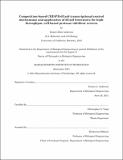| dc.description.abstract | Catalytically-dead Cas9 (dCas9) is a programmable transcription factor that can be targeted to promoters through the design of small guide RNAs (sgRNAs), where it can function as an activator or repressor. In Chapter 1 of this thesis, I outline the multitude of tools and applications that have been developed for dCas9 circuits. I then discuss the limitations and advantages of these systems and and outline some of the most promising opportunities for dCas9-based genetic circuits.
In Chapter 2, I devise, model, and implement a new-to-nature transcriptional control mechanism using dCas9. Natural promoters use overlapping binding sites as a mechanism for signal integration, where the binding of one transcription factor can augment the activity of another. Here, I implement this strategy in Escherichia coli using pairs of sgRNAs designed to repress and then derepress transcription through competitive binding. I demonstrate that this mechanism can control both transcriptional initiation and transcriptional elongation with over 30-fold dynamic range. This work characterizes and demonstrates a new genetic control modality that could be used to build analog circuits or to implement cis-regulatory logic on CRISPRi-targeted native genes.
In the final chapter of this thesis, I use a dCas9 genetic circuit to create an in vivo selection system for protease inhibitors. By leveraging a previously-described dCas9 toolkit, I create a synthetic genetic circuit that responds to SARS-CoV-2 viral protease activity. Using this circuit as an in vivo biosensor, I integrate it with a RiPP-based molecular library and an in vivo selection system to screen for inhibitors of the SARS-CoV-2 Papain-like protease (PLpro). With this integrated system, I screened tens of millions of RiPPs and identified DAA680, a 13-AA modified peptide with PLpro inhibitory activity. However, follow-up studies showed that this peptide also inhibits another SARS-CoV-2 viral protease, CLpro, indicating a non-specific mechanism of inhibition. Nonetheless, these results validate our system’s ability to identify and isolate RiPP-based protease inhibitors from large libraries. Additionally, our extensive characterization of the selection system should be generalizable to any biosensor with a transcriptional output. This should enable the rapid deployment of novel cell-based selection methods that can identify molecules with diverse bioactivities. | |
